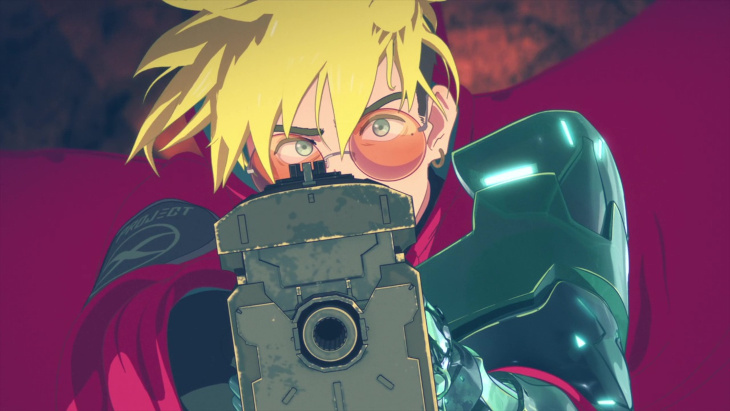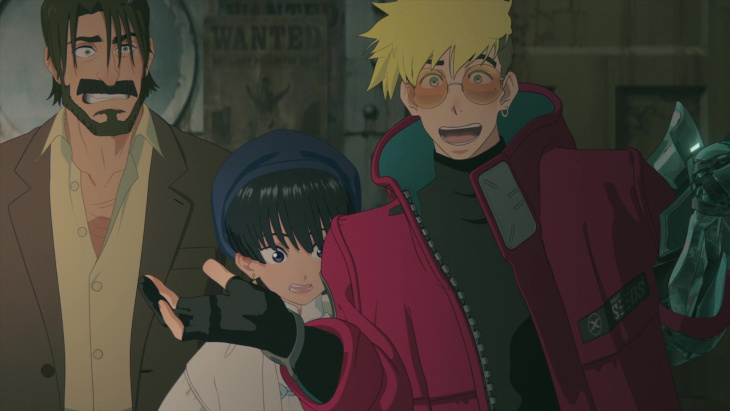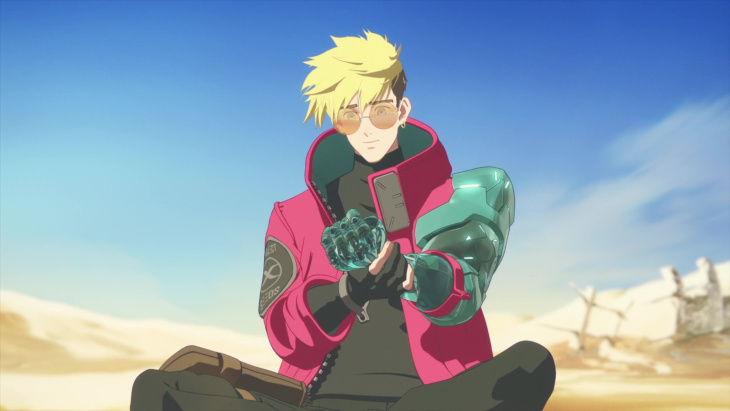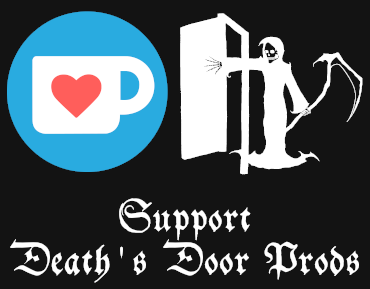
“Millions Knives. Have you ever heard that name?”
My feelings on Trigun are almost as complicated as the history of the work itself. Despite being a hit in the west, it was never that popular in Japan. Furthermore, while the anime made a big splash in the U.S. due in part to its sci-fi cowboy aesthetic, I was never a big fan as I found it a bit too off-kilter for my liking. I enjoyed the manga to a point, but Yasushiro Nightow’s art, despite being gorgeous, can be difficult to make sense of, and I never completed it. The first anime strays heavily from its then-canceled, later-uncanceled source material, so I’d long wondered whether I’d enjoy a more loyal adaptation. So, does this long awaited return to the franchise, 25 years in the making, finally scratch that itch? It’s a little hard to say. I definitely don’t have an answer to that question based on episode 1, because rather than a loyal retelling of the original work, Trigun Stampede is an all new reinterpretation with a new art style, new production company, and reworked story. Thus, it’s genuinely not feasible to judge its trajectory based on previous efforts. As it stands, Trigun Stampede is an interesting project and offers its viewers a decent amount of fun comedy and action, though references to plot elements from the original work may prove distracting for returning viewers.

The show follows Vash the Stampede, a bizarre goofball who seems to be followed by chaos and destruction. The governments of the desolate planet of Noman’s Land have placed a bounty of $$6,000,000 on his head. The bounty has been dropped from the 60 billion value of previous entries, though the Double Dollar currency seems to have stuck around. Two reporters, Meryl Strife and Roberto Niro, stumble across him in the desert, tied up and hanging from a tree, but decide to wait until after they can interview him to turn him in. They bring him to a nearby town to get some food and talk with him, but find that the locals have nothing but affection for Vash and credit him with saving their town. It’s fascinating to observe this new installment in the franchise and examine not only the details that are different, but also how the presentation of the shared elements differs. For instance, the episode begins with the death of Rem, which is a startling way to kick off the narrative. Seriously, when was the first time Millions Knives’ name was mentioned in the manga or the 90’s anime? Between the opening flashbacks, and the ending straight-up mentioning him by name, the approach of this adaptation will seem notably different from previous ones. Whether that’s a good or bad thing remains to be seen. It may provide more clarity of direction early on, which is something the Madhouse Trigun lacked, but those familiar with it may find the dissonance of Stampede’s approach distracting.

The art is largely solid, which is a relief, given the risk Orange took here. Like many, I was a bit iffy on the idea of a Trigun adaptation being produced using CG animation, and there is a basis for that, beyond simple CG-prejudice. Trigun had a very gritty visual style to it, even if the antics of Vash clashed dramatically with that motif. CG is less proficient at depicting those busy, heavily textured designs, and I won’t deny that, in the back of my mind, I still wonder if that’s the reason they did away with Vash’s iconic coat, as the depiction of it fluttering in the wind with its numerous bullet holes might become labor intensive after a while. I don’t honestly mind its exclusion though, and if I take issue with any aspect of the character designs, it is with Vash’s mechanical arm, which has a distractingly shiny texture. This is doubly problematic, as it constantly draws the eye, and it also has that same, “This came up much later,” quality as some of the previously mentioned story beats from this episode. Aside from that one gripe, I don’t have many qualms with the production of this episode. The character movements have some of that exaggerated quality you sometimes see in 3D series, but I wouldn’t be surprised if Orange left those in on purpose, because they match Trigun’s tone. Orange has certainly made a name for itself with its adaptations of Land of the Lustrous and Beastars, but this marks the first production from them I’ve encountered, and I have to admit that I’m impressed.
Before I wrap up, a few Notes and Nitpicks:
- I used to own the first two DVDs of the original Trigun anime, despite my lack of affinity for it. This was back in the days of the mid-2000’s, when, if you found a copy of a used anime DVD for cheap, it didn’t matter if you were a fan or not, you bought it AND YOU LIKED IT! Joking aside, I started reading the manga before watching the anime, so I was greatly perplexed by those early episodes. The first DVD is almost entirely anime original.
- I’d have assumed the music that plays at the end of this episode was the ED, but evidently that’s the OP. It’s a much more chill tone than I’d expected, but honestly, it kind of works for me, even if it sounds like the anime equivalent of Jack Johnson.
- So, is Millie Thompson not in this version? I have nothing against Meryl’s new partner, Roberto… de Niro? Did they ever say his full name? If so, I’m shocked I missed that. Anyway, if they don’t have Millie in this version, that’s a legitimate shame.




Add comment